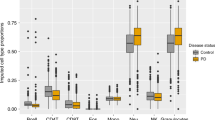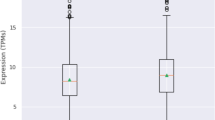Abstract
The cytosolic aryl sulfotransferase genes SULT1A3 and SULT1A4 are located on chromosome 16p11.2 in a region of chromosomal instability. SULT1A3/4 are important enzymes in the metabolism of catecholamines linked to neurodegenerative diseases such as Parkinson’s and Alzheimer’s. In the present study, copy number variation of the SULT1A3/4 genes in healthy individuals, as well as a cohort of Parkinson’s disease and Alzheimer’s disease patients was examined. In all subjects, SULT1A3/4 copy number varied from 1 to 10. In Alzheimer’s disease patients, there was a significantly lower copy number compared to controls, and a positive correlation between copy number and age of disease onset. By contrast, there were no differences in Parkinson’s disease patients. However, when early-onset Parkinson’s disease was evaluated separately, there appeared to be an association with gene copy number and risk. The current study shows that these neurodegenerative diseases may be related to SULT1A3/4 copy number.
This is a preview of subscription content, access via your institution
Access options
Subscribe to this journal
Receive 6 print issues and online access
$259.00 per year
only $43.17 per issue
Buy this article
- Purchase on Springer Link
- Instant access to full article PDF
Prices may be subject to local taxes which are calculated during checkout





Similar content being viewed by others
References
Riches Z, Stanley EL, Bloomer JC, Coughtrie MW . Quantitative evaluation of the expression and activity of five major sulfotransferases (SULTs) in human tissues: the SULT "pie". Drug Metab Dispos 2009; 37: 2255–2261.
Eisenhofer G, Kopin IJ, Goldstein DS . Catecholamine metabolism: a contemporary view with implications for physiology and medicine. Pharmacol Rev 2004; 56: 331–349.
Johnson GA, Baker CA, Smith RT . Radioenzymatic assay of sulfate conjugates of catecholamines and DOPA in plasma. Life Sci 1980; 26: 1591–1598.
Salman ED, Kadlubar SA, Falany CN . Expression and localization of cytosolic sulfotransferase (SULT) 1A1 and SULT1A3 in normal human brain. Drug Metab Dispos 2009; 37: 706–709.
Samonte RV, Eichler EE . Segmental duplications and the evolution of the primate genome. Nat Rev Genet 2002; 3: 65–72.
Bradley ME, Benner SA . Phylogenomic approaches to common problems encountered in the analysis of low copy repeats: the sulfotransferase 1A gene family example. BMC Evol Biol 2005; 5: 22.
Dajani R, Cleasby A, Neu M, Wonacott AJ, Jhoti H, Hood AM et al. X-ray crystal structure of human dopamine sulfotransferase, SULT1A3. Molecular modeling and quantitative structure-activity relationship analysis demonstrate a molecular basis for sulfotransferase substrate specificity. J Biol Chem 1999; 274: 37862–37868.
Dajani R, Hood AM, Coughtrie MW . A single amino acid, glu146, governs the substrate specificity of a human dopamine sulfotransferase, SULT1A3. Mol Pharmacol 1998; 54: 942–948.
Gamage N, Barnett A, Hempel N, Duggleby RG, Windmill KF, Martin JL et al. Human sulfotransferases and their role in chemical metabolism. Toxicol Sci 2006; 90: 5–22.
Hildebrandt MA, Salavaggione OE, Martin YN, Flynn HC, Jalal S, Wieben ED et al. Human SULT1A3 pharmacogenetics: gene duplication and functional genomic studies. Biochem Biophys Res Commun 2004; 321: 870–878.
Rosenfeld JA, Coppinger J, Bejjani BA, Girirajan S, Eichler EE, Shaffer LG et al. Speech delays and behavioral problems are the predominant features in individuals with developmental delays and 16p11.2 microdeletions and microduplications. J Neurodev Disord 2010; 2: 26–38.
Fernandez BA, Roberts W, Chung B, Weksberg R, Meyn S, Szatmari P et al. Phenotypic spectrum associated with de novo and inherited deletions and duplications at 16p11.2 in individuals ascertained for diagnosis of autism spectrum disorder. J Med Genet 2010; 47: 195–203.
Weiss LA, Shen Y, Korn JM, Arking DE, Miller DT, Fossdal R et al. Association between microdeletion and microduplication at 16p11.2 and autism. N Engl J Med 2008; 358: 667–675.
Mohd Fadley MA, Ismail A, Keong TM, Yusoff NM, Zakaria Z . Chromosomal 16p microdeletion in Rubinstein-Taybi syndrome detected by oligonucleotide-based array comparative genomic hybridization: a case report. J Med Case Rep 2012; 6: 30.
Jacquemont S, Reymond A, Zufferey F, Harewood L, Walters RG, Kutalik Z et al. Mirror extreme BMI phenotypes associated with gene dosage at the chromosome 16p11.2 locus. Nature 2011; 478: 97–102.
McCarthy SE, Makarov V, Kirov G, Addington AM, McClellan J, Yoon S et al. Microduplications of 16p11.2 are associated with schizophrenia. Nat Genet 2009; 41: 1223–1227.
Shinawi M, Liu P, Kang SH, Shen J, Belmont JW, Scott DA et al. Recurrent reciprocal 16p11.2 rearrangements associated with global developmental delay, behavioural problems, dysmorphism, epilepsy, and abnormal head size. J Med Genet 2010; 47: 332–341.
Hebbring SJ, Adjei AA, Baer JL, Jenkins GD, Zhang J, Cunningham JM et al. Human SULT1A1 gene: copy number differences and functional implications. Hum Mol Genet 2007; 16: 463–470.
Gaedigk A, Twist GP, Leeder JS . CYP2D6, SULT1A1 and UGT2B17 copy number variation: quantitative detection by multiplex PCR. Pharmacogenomics 2012; 13: 91–111.
Edavana VK, Yu X, Dhakal IB, Williams S, Ning B, Cook IT et al. Sulfation of fulvestrant by human liver cytosols and recombinant SULT1A1 and SULT1E1. Pharmacogenomics Personal Med 2011; 4: 137–145.
Yu X, Dhakal IB, Beggs M, Edavana VK, Williams S, Zhang X et al. Functional genetic variants in the 3'-untranslated region of sulfotransferase isoform 1A1 (SULT1A1) and their effect on enzymatic activity. Toxicol Sci 2010; 118: 391–403.
Hebbring SJ, Moyer AM, Weinshilboum RM . Sulfotransferase gene copy number variation: pharmacogenetics and function. Cytogenet Genome Res 2008; 123: 205–210.
Sutherland GT, Halliday GM, Silburn PA, Mastaglia FL, Rowe DB, Boyle RS et al. Do polymorphisms in the familial Parkinsonism genes contribute to risk for sporadic Parkinson's disease? Move Disord 2009; 24: 833–838.
Ellis KA, Bush AI, Darby D, De Fazio D, Foster J, Hudson P et al. The Australian Imaging, Biomarkers and Lifestyle (AIBL) study of aging: methodology and baseline characteristics of 1112 individuals recruited for a longitudinal study of Alzheimer's disease. Int Psychogeriatr 2009; 21: 672–687.
Kotschet K, Johnson W, McGregor S, Kettlewell J, Kyoong A, O'Driscoll DM et al. Daytime sleep in Parkinson's disease measured by episodes of immobility. Parkinson Relat Disord 2014; 20: 578–583.
Twelves D, Perkins KS, Counsell C . Systematic review of incidence studies of Parkinson's disease. Mov Disord 2003; 18: 19–31.
Rowe CC, Ellis KA, Rimajova M, Bourgeat P, Pike KE, Jones G et al. Amyloid imaging results from the Australian Imaging, Biomarkers and Lifestyle (AIBL) study of aging. Neurobiol Aging 2010; 31: 1275–1283.
Vandenberghe R, Van Laere K, Ivanoiu A, Salmon E, Bastin C, Triau E et al. 18F-flutemetamol amyloid imaging in Alzheimer disease and mild cognitive impairment: a phase 2 trial. Ann Neurol 2010; 68: 319–329.
Wong DF, Rosenberg PB, Zhou Y, Kumar A, Raymont V, Ravert HT et al. In vivo imaging of amyloid deposition in Alzheimer disease using the radioligand 18F-AV-45 (florbetapir [corrected] F 18). J Nucl Med 2010; 51: 913–920.
Shadravan F . Sex bias in copy number variation of olfactory receptor gene family depends on ethnicity. Front Genet 2013; 4: 32.
Klopocki E, Lohan S, Doelken SC, Stricker S, Ockeloen CW, Soares Thiele de Aguiar R et al. Duplications of BHLHA9 are associated with ectrodactyly and tibia hemimelia inherited in non-Mendelian fashion. J Med Genet 2012; 49: 119–125.
Trillo L, Das D, Hsieh W, Medina B, Moghadam S, Lin B et al. Ascending monoaminergic systems alterations in Alzheimer's disease. Translating basic science into clinical care. Neurosci Biobehav Rev 2013; 37: 1363–1379.
Gannon M, Che P, Chen Y, Jiao K, Roberson ED, Wang Q . Noradrenergic dysfunction in Alzheimer's disease. Front Neurosci 2015; 9: 220.
Raskind MA, Peskind ER, Halter JB, Jimerson DC . NOrepinephrine and mhpg levels in csf and plasma in alzheimer's disease. Arch Gen Psychiatry 1984; 41: 343–346.
Elrod R, Peskind ER, DiGiacomo L, Brodkin KI, Veith RC, Raskind MA . Effects of Alzheimer's disease severity on cerebrospinal fluid norepinephrine concentration. Am J Psychiatry 1997; 154: 25–30.
Tyce GM, Messick JM, Yaksh TL, Byer DE, Danielson DR, Rorie DK . Amine sulfate formation in the central nervous system. Federation Proc 1986; 45: 2247–2253.
Villemagne VL, Pike KE, Chetelat G, Ellis KA, Mulligan RS, Bourgeat P et al. Longitudinal assessment of Abeta and cognition in aging and Alzheimer disease. Ann Neurol 2011; 69: 181–192.
Chetelat G, Villemagne VL, Pike KE, Ellis KA, Bourgeat P, Jones G et al. Independent contribution of temporal beta-amyloid deposition to memory decline in the pre-dementia phase of Alzheimer's disease. Brain 2011; 134: 798–807.
International Parkinson's Disease Genomics C Wellcome Trust Case Control C. A two-stage meta-analysis identifies several new loci for Parkinson's disease. PLoS Genet 2011; 7: e1002142.
Lipton J, Rivkin MJ . 16p11.2-related paroxysmal kinesigenic dyskinesia and dopa-responsive parkinsonism in a child. Neurology 2009; 73: 479–480.
Sidharthan NP, Minchin RF, Butcher NJ . Cytosolic sulfotransferase 1A3 is induced by dopamine and protects neuronal cells from dopamine toxicity: role of D1 receptor-N-methyl-D-aspartate receptor coupling. J Biol Chem 2013; 288: 34364–34374.
Marazziti D, Golini E, Mandillo S, Magrelli A, Witke W, Matteoni R et al. Altered dopamine signaling and MPTP resistance in mice lacking the Parkinson's disease-associated GPR37/parkin-associated endothelin-like receptor. Proc Natl Acad Sci USA 2004; 101: 10189–10194.
Zhang L, Le W, Xie W, Dani JA . Age-related changes in dopamine signaling in Nurr1 deficient mice as a model of Parkinson's disease. Neurobiol Aging 2012; 33: 1001.e1007–1001.e1016.
Kurz A, Double KL, Lastres-Becker I, Tozzi A, Tantucci M, Bockhart V et al. A53T-alpha-synuclein overexpression impairs dopamine signaling and striatal synaptic plasticity in old mice. PLoS ONE 2010; 5: e11464.
Sutherland GT, Matigian NA, Chalk AM, Anderson MJ, Silburn PA, Mackay-Sim A et al. A cross-study transcriptional analysis of Parkinson's disease. PLoS ONE 2009; 4: e4955.
Narayanan NS, Rodnitzky RL, Uc EY . Prefrontal dopamine signaling and cognitive symptoms of Parkinson's disease. Rev Neurosci 2013; 24: 267–278.
Klein C, Westenberger A . Genetics of Parkinson’s disease. Cold Spring Harb Perspect Med 2012; 2: a008888.
Taskinen J, Ethell BT, Pihlavisto P, Hood AM, Burchell B, Coughtrie MW . Conjugation of catechols by recombinant human sulfotransferases, UDP-glucuronosyltransferases, and soluble catechol O-methyltransferase: structure-conjugation relationships and predictive models. Drug Metab Dispos 2003; 31: 1187–1197.
Zollner S, Teslovich TM . Using GWAS data to identify copy number variants contributing to common complex diseases. Stat Sci 2009; 24: 530–546.
Usher CL, McCarroll SA . Complex and multi-allelic copy number variation in human disease. Brief Funct Genomics 2015; 14: 329–338.
Martin CL, Kirkpatrick BE, Ledbetter DH . Copy number variants, aneuploidies, and human disease. Clin Perinatol 2015; 42: 227–242, vii.
Mikhail FM . Copy number variations and human genetic disease. Curr Opin Pediatr 2014; 26: 646–652.
Lin MK, Farrer MJ . Genetics and genomics of Parkinson's disease. Genome Med 2014; 6: 48.
Acknowledgements
This work was supported by a grant from the National Health and Medical Research Council (Grant number 1005899).
Author information
Authors and Affiliations
Consortia
Corresponding author
Ethics declarations
Competing interests
The authors declare no conflict of interest.
Rights and permissions
About this article
Cite this article
Butcher, N., Horne, M., Mellick, G. et al. Sulfotransferase 1A3/4 copy number variation is associated with neurodegenerative disease. Pharmacogenomics J 18, 209–214 (2018). https://doi.org/10.1038/tpj.2017.4
Received:
Revised:
Accepted:
Published:
Issue Date:
DOI: https://doi.org/10.1038/tpj.2017.4
This article is cited by
-
The contribution of CNVs to the most common aging-related neurodegenerative diseases
Aging Clinical and Experimental Research (2021)
-
Link between short tandem repeats and translation initiation site selection
Human Genomics (2018)
-
Analyses of the genetic diversity and protein expression variation of the acyl: CoA medium-chain ligases, ACSM2A and ACSM2B
Molecular Genetics and Genomics (2018)



